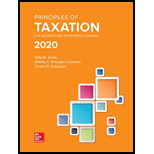
Concept explainers
Investor W has the opportunity to invest $500,000 in a new venture. The projected cash flows from the venture are as follows:

Investor W uses a 7 percent discount rate to compute
- a. Her marginal tax rate over the life of the investment is 15 percent.
- b. Her marginal tax rate over the life of the investment is 20 percent.
- c. Her marginal tax rate in years 1 and 2 is 10 percent and in years 3 and 4 is 25 percent.
a.
Calculate net present value (NPV) and identify whether Investor W should make the investment or not.
Explanation of Solution
Calculate net present value (NPV) and identify whether Investor W should make the investment or not.
Step 1: Calculate present value.
| Year 0 | Year 1 | Year 2 | Year 3 | Year 4 | |
| Before-tax cash flow | $(500,000) | $52,500 | $47,500 | $35,500 | $530,500 |
| Less: Tax cost | - | $(7,875) | $(7,125) | $(5,325) | $(4,575) |
| After-tax cash flow | - | $44,625 | $40,375 | $30,175 | $525,925 |
| Multiply: Discount factor at 7% | - | ||||
| Present value | $(500,000) | $41,724 | $35,247 | $24,623 | $401,281 |
Working note:
Calculate tax cost.
| Year 1 | Year 2 | Year 3 | Year 4 | |
| Taxable income | $52,500 | $47,500 | $35,500 | $30,500 |
| Multiply: Marginal tax rate | ||||
| Tax cost | $7,875 | $7,125 | $5,325 | $4,575 |
Step 2: Calculate NPV.
The value of net present value (NPV) is positive. Hence, Investor W should make the investment.
b.
Calculate net present value (NPV) and identify whether Investor W should make the investment or not.
Explanation of Solution
Calculate net present value (NPV) and identify whether Investor W should make the investment or not.
Step 1: Calculate present value.
| Year 0 | Year 1 | Year 2 | Year 3 | Year 4 | |
| Before-tax cash flow | $(500,000) | $52,500 | $47,500 | $35,500 | $530,500 |
| Less: Tax cost | - | $(10,500) | $(9,500) | $(7,100) | $(6,100) |
| After-tax cash flow | - | $42,000 | $38,000 | $28,400 | $524,400 |
| Multiply: Discount factor at 7% | - | ||||
| Present value | $(500,000) | $39,270 | $33,174 | $23,174 | $400,117 |
Working note:
Calculate tax cost.
| Year 1 | Year 2 | Year 3 | Year 4 | |
| Taxable income | $52,500 | $47,500 | $35,500 | $30,500 |
| Multiply: Marginal tax rate | ||||
| Tax cost | $10,500 | $9,500 | $7,100 | $6,100 |
Step 2: Calculate NPV.
The value of net present value (NPV) is negative. Hence, Investor W should not make the investment.
c.
Calculate net present value (NPV) and identify whether Investor W should make the investment or not.
Explanation of Solution
Calculate net present value (NPV) and identify whether Investor W should make the investment or not.
Step 1: Calculate present value.
| Year 0 | Year 1 | Year 2 | Year 3 | Year 4 | |
| Before-tax cash flow | $(500,000) | $52,500 | $47,500 | $35,500 | $530,500 |
| Less: Tax cost | - | $(5,250) | $(4,750) | $(8,875) | $(7,625) |
| After-tax cash flow | - | $47,250 | $42,750 | $26,625 | $522,875 |
| Multiply: Discount factor at 7% | - | ||||
| Present value | $(500,000) | $44,179 | $37,321 | $21,726 | $398,954 |
Working note:
Calculate tax cost.
| Year 1 | Year 2 | Year 3 | Year 4 | |
| Taxable income | $52,500 | $47,500 | $35,500 | $30,500 |
| Multiply: Marginal tax rate | ||||
| Tax cost | $5,250 | $4,750 | $8,875 | $7,625 |
Step 2: Calculate NPV.
The value of net present value (NPV) is positive. Hence, Investor W should make the investment.
Want to see more full solutions like this?
Chapter 3 Solutions
Principles of Taxation for Business and Investment Planning 2020 Edition
- DETERMINING THE RIGHT AM OUNT OF SHORT-TERM, LIQUID INVESTM ENTS. Leo and Ava Bryant together earn approximately 92,000 a year after taxes. Through an inheritance and some wise investing, they also have an investment portfolio with a value of almost 200,000. a. How much of their annual income do you recommend the Bryants hold in some form of liquid savings as reserves? Explain. b. How much of their investment portfolio do you recommend they hold in savings and other short-term investment vehicles? Explain. c. How much, in total, should they hold in short-term liquid assets?arrow_forwardMarlo and Merlins son, Alex, needs 20,000 to start a business. They have 30,000 in securities that they can use to give him the capital he needs. Pertinent information regarding the securities is given below: Marlo and Merlin are in the 28 percent marginal tax rate bracket; Alex is in the 15 percent marginal tax rate bracket. Neither Marlo, Merlin, nor Alex has any other capital asset transactions during the year. Alexs basis in any of the securities gifted to him will be the lesser of his parents basis or the fair market value of the security. Discuss the tax effects of alternate methods of transferring 20,000 to Alex, and devise an optimal plan for making the transfer.arrow_forwardCarmen Santiago decided to invest $12,000 in shares of the AT&T company that pays her 5% in dividends each year. In 5 years, she will sell the shares for market value, which she estimates will have increased in value by 1% of their original value. The combined marginal tax rate she applies is 39%. If the inflation rate is 6%, DETERMINE: The internal rate of return before taxes, ignoring inflationarrow_forward
- Stan and Alicia can invest $40000 in preffered stock A which pay a dividend of $2000 a year, payable quarterly. They will re - invest the dividends in a savings account which presently earnes 3% compounded yearly. They expect the stock will reach a selling price of $44000 in 4 years. Assume a regular income marginal tax rate of 43%, and a dividend marginal tax rate of 17.45%, and a capital gains marginal tax rate of 21.5%. What is the after - tax EAR of this tock? Assume taxation is paid annually for the interests and dividends. (Calculate using HPR before and after tax) Ans: 5.72% ( Step by Step solution)arrow_forwardIrene is saving for a new car she hopes to purchase either four or six years from now. Irene invests $10,000 in a growth stock that does not pay dividends and expects a 6 percent annual before-tax return (the investment is tax deferred). When she cashes in the investment after either four or six years, she expects the applicable marginal tax rate on long-term capital gains to be 25 percent. (For all requirements, do not round intermediate calculations. Round your final answers to nearest whole dollar amount.) a. What will be the value of this investment four and six years from now? b. When Irene sells the investment, how much cash will she have after taxes to purchase the new car (four and six years from now)?arrow_forwardKomiko Tanaka invests $13,000 in LymaBean, Inc. LymaBean does not pay any dividends. Komiko projects that her investment will generate a 10 percent before-tax rate of return. She plans to invest for the long term. a. How much cash will Komiko retain, after-taxes, if she holds the investment for five years and then she sells it when the long-term capital gains rate is 15 percent?arrow_forward
- A taxpayer can invest $1,000 in a money market fund that yields an annual pretax rate of return of 8% or buy an acre of land for $1,000 that appreciates at a 7% annual rate. The taxpayer plans to sell the land after 20 years and faces a 25% tax rate each year. (For purposes of this problem, ignore any risk differences between investments.) What is the after-tax accumulation at the end of 20 years from each investment? What is the annualized after-tax rate of return from each investment?arrow_forwardElla and Aaron Martin together earn approximately $92,000 a year after taxes. Through an inheritance and some wise investing, they also have an investment portfolio with a value of almost $200,000. a. How much of their annual income do you recommend the Martins hold in some form of liquid savings as reserves? Explain. b. How much of their investment portfolio do you recommend they hold in savins and other short-term investment vehicles? Explain. c. How much, in total, should they hold in short-term liquid assets?arrow_forwardKomiko Tanaka invests $18,000 in LymaBean, Inc. LymaBean does not pay any dividends. Komiko projects that her investment will generate a 10 percent before-tax rate of return. She plans to invest for the long term. How much cash will Komiko retain, after-taxes, if she holds the investment for 5 years and then sells when the long-term capital gains rate is 25 percent? (Do not round intermediate calculations. Round your final answer to the nearest whole dollar amount.) What is Komiko’s after-tax rate of return on her investment in part (c)? (Do not round intermediate calculations. Round your percentage answer to 2 decimal places.) e. How much cash will Komiko retain, after taxes, if she holds the investment for 15 years and then she sells when the long-term capital gains rate is 15 percent? (Do not round intermediate calculations. Round your final answer to the nearest whole dollar amount.) f. What is Komiko’s after-tax rate of return on her…arrow_forward
- Stan and Alicia can invest $40000 in preffered stock A which pay a dividend of $2000 a year, payable quarterly. They will re-invest the dividends in a savings account which presently earnes 3% compounded yearly. They expect the stock will reach a selling price of $44000 in 4 years. Assume a regular income marginal tax rate of 43%, and a dividend marginal tax rate of 17.4 5%, and a capital gains marginal tax rate of 21.5%. What is the after-tax EAR of this tock? Assume taxation is paid annually for the interests and dividends.arrow_forwardWalt is evaluating an investment that will provide the following returns at the end of each of the following years: year I, $12,500; year 2, $10,000; year 3, $7,500; year 4,$5,000; year 5, $2,500; year 6, SO; and year 7, $12,500. Walt believes that he should earn 12 percent compounded annu- ally on this investment. How much should he pay for this investment? What if he expects to earn an annual return of 9 percent compounded monthly? How much should he pay? excel formula.arrow_forwardPattison family considers the opportunity to finance the purchase of their first $500 thousand worthsingle-family house in Santa Rosa, CA. To qualify for a 30-year fixed-rate mortgage, the downpayment should be 10% of the purchase price. To accumulate money for the down payment, Mr.Pattison plans to invest $35,000 in the stock portfolio that earns 7.65% per annum. Assume that Mr.Pattison reinvests annual gains at the same interest rate as the initial investment. How much moneywill Mr. Pattison accumulate with this investment within five years? Is the initial investmentamount sufficient to accumulate in five years the required down payment under the abovemortgage? Round your answers to the nearest dollar. Show your work.arrow_forward
 Pfin (with Mindtap, 1 Term Printed Access Card) (...FinanceISBN:9780357033609Author:Randall Billingsley, Lawrence J. Gitman, Michael D. JoehnkPublisher:Cengage Learning
Pfin (with Mindtap, 1 Term Printed Access Card) (...FinanceISBN:9780357033609Author:Randall Billingsley, Lawrence J. Gitman, Michael D. JoehnkPublisher:Cengage Learning PFIN (with PFIN Online, 1 term (6 months) Printed...FinanceISBN:9781337117005Author:Randall Billingsley, Lawrence J. Gitman, Michael D. JoehnkPublisher:Cengage Learning
PFIN (with PFIN Online, 1 term (6 months) Printed...FinanceISBN:9781337117005Author:Randall Billingsley, Lawrence J. Gitman, Michael D. JoehnkPublisher:Cengage Learning Individual Income TaxesAccountingISBN:9780357109731Author:HoffmanPublisher:CENGAGE LEARNING - CONSIGNMENT
Individual Income TaxesAccountingISBN:9780357109731Author:HoffmanPublisher:CENGAGE LEARNING - CONSIGNMENT





